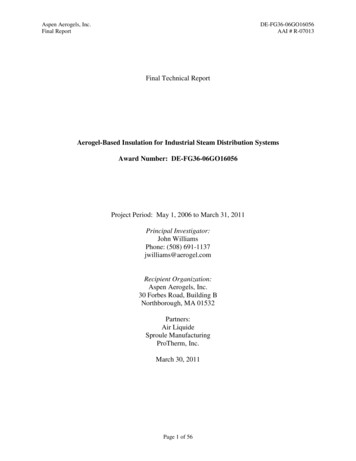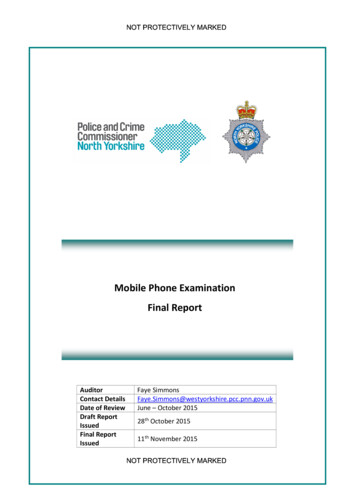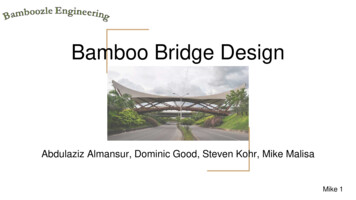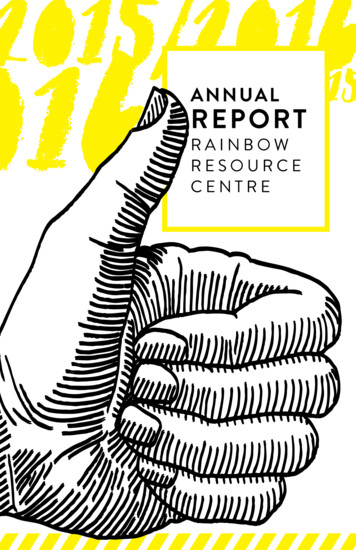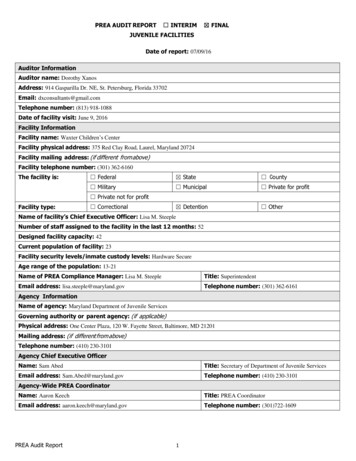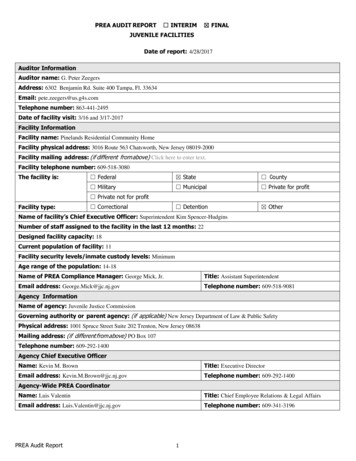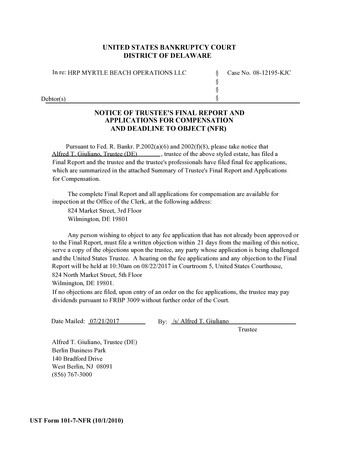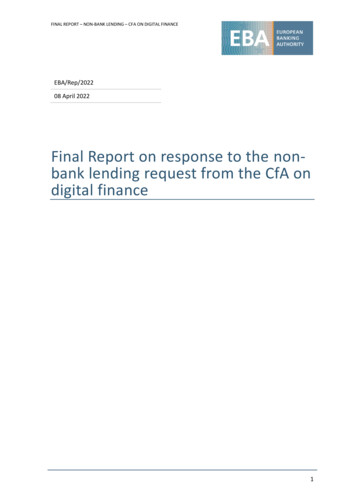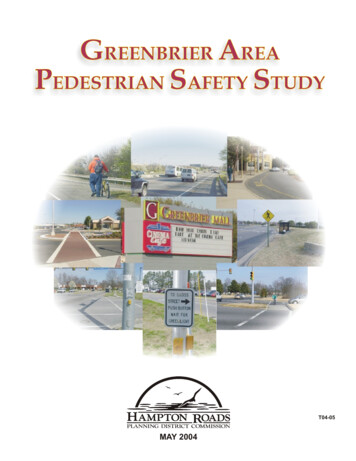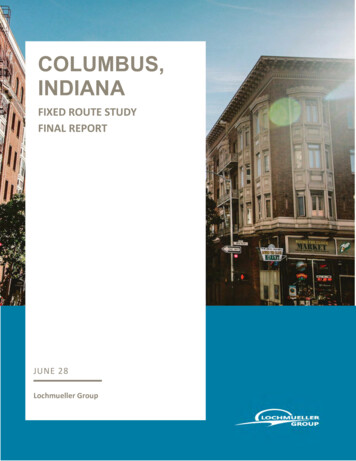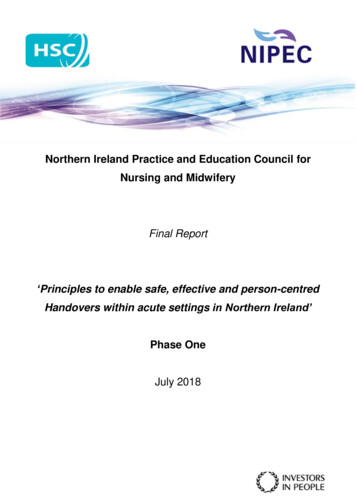
Transcription
Northern Ireland Practice and Education Council forNursing and MidwiferyFinal Report‘Principles to enable safe, effective and person-centredHandovers within acute settings in Northern Ireland’Phase OneJuly 20181
42.0Background53.0Project 38.0Outcomes: Principles for an Effective Handover andNursing Handover Prompt SheetConclusion and Recommendations9.0References21Appendices Appendix 1: Project Team Membership1922Appendix 2: Terms of Reference23Appendix 3: Programme of work25Appendix 4: Literature review26Appendix 5: Effective Handover Survey Results33 Area of PracticeRespondents by BandingNumber of Handovers per dayTime allocated and time taken forHandover Table 5: Types of documentation respondentsstated used for handover33343435Appendix 6: Principles for an Effective Handover42 Annex A: Nursing Handover Prompt Sheet47Table 1:Table 2:Table 3:Table 4:362
ACKNOWLEDGEMENTAs Chair of the Effective Handover Project Group, I would like to thank those staff from thefive Health & Social Care Trusts, the Royal College of Nursing and the three HigherEducation Institutes who gave freely of their time to contribute to the development of thePrinciples to enable Effective Handover in acute adult settings.In particular, I wish to acknowledge the members of the Effective Handover Project Groupwho through their contribution, commitment, collaboration and partnership working,enabled the successful overall achievement of this project.Finally, I wish to thank NIPEC's, administrative and information technology staff, for theirsignificant contribution to the completion of this report.Linda KellyAssistant Director of Nursing: Safe and Effective CareSouth Eastern Health & Social Care TrustChair of the Effective Handover Project Group3
1.0 INTRODUCTION1.1 The Northern Ireland Practice and Education Council for Nurses and Midwives(NIPEC) engages with a wide range of stakeholders to identify the key priorities inhealth and social care for nursing and midwifery in Northern Ireland that informNIPEC’s Vision and Business Plans. A priority from a recent stakeholder event wasthat NIPEC would ‘Develop principles to enable safe, effective and personcentred Handovers within acute settings in Northern Ireland.’1.2 There was a view presented at the NIPEC stakeholder event that handovers varyacross the five HSC Trusts with regard to content, duration and approach. Adverseincidents (O’Hara, 2018, Keogh, 2013, HIQA, 2013, Francis, 2013 & NCEC, 2013)have highlighted the requirement for effective communication processes to underpinthe provision of care.In addition The NMC Code (2015) ‘requires nurses andmidwives to provide a high standard of practice and care at all times through alwayspractising in line with the best available evidence, communicating effectively’.1.3 The World Health Organisation (WHO) listed improved communications in handoverin its top five safety solutions (2007), highlighting handover as the most frequent andsignificant communication process in the delivery of patient care, estimating thatthere are approximately 100 million handovers each year and that handovercommunication is responsible for 25 to 40 % of adverse events.1.4 The nursing and midwifery ‘change of handover’ or ‘shift report’, as they arecommonly referred to by the nursing and midwifery professions, is a communicationprocess which occurs between two shifts of nurses or midwives with the specificpurpose to communicate information about patients under their care (Lamond,2000).Randell (2011). This suggests that Clinical Handover refers to the explicittransfer of professional responsibility and accountability for a patient, or agroup of patients, to another person or professional group, on a temporary orpermanent basis. Other common terms for this activity are: Shift Handover, Handoffor Nursing Report. For the purpose of this project, the term Handover will be used.4
2.0 BACKGROUND2.1 To date, there is limited evidence to determine which form of handover supportsperson centred practise for patients and their families, and for staff. Smeulers et al(2014) explored the available literature to determine the effectiveness of differentnursing handover styles and concluded that at present there is limited high qualityevidence.2.2 To minimise the risk to individuals under our care, Randell (2011) suggests that thereshould be explicit agreement on: the location where handover takes place; thecontent and the degree of detail; the use of a structured approach; parametersaround the duration and timings of handover, and identification of participants whoneed to be present; as well as exploring the actions that could be taken to minimiseinterruptions.3.0 PROJECT PLANProject Aim3.1 The aim of the project was to ‘Develop principles to enable safe, effective andperson-centred Handovers within acute settings in Northern Ireland.’ObjectivesThe objectives of the Project were to:3.2 Develop an engagement strategy for key stakeholders.3.3 Conduct a literature search and identify best practice in relation to safe and effectiveperson-centred handovers.3.4 Scope the relationship and interface with other clinical communication activitiesincluding Ward Rounds, Safety Briefs, Huddles, Multidisciplinary Team meetings,White Board Reports, ward and inter hospital transfers, and PACE Care Planning.5
3.5 Identify and agree the core elements of a safe and effective person-centredhandover.3.6 Develop regional principles to be adopted across Northern Ireland that will:i.enable patients to take a lead role in their careii.support the delivery of person centred outcomes for safe and effective careand servicesiii.satisfy the requirements of the NMC Code.3.7 Identify proposals for implementation and spread, including challenges and signpostwhere further work may be required.3.8 Make recommendations for suitability for spread in acute settings.3.9 Consider impact of electronic notation within the recommendations.4.0 METHODOLOGYTo deliver on the objectives the following actions were taken:4.1 The Project Group was convened in June 2017 with representatives across nursingand midwifery including, service providers, education, system regulation and staffside (Appendix 1) to enable key stakeholders to be actively involved in this work. AHSC Trust Assistant Director of Nursing with responsibility for Safe and EffectiveCare, acted as the project chairperson. The members of the Project Group agreedterms of reference (Appendix 2) and a project plan which included the scope of thiswork (Appendix 3).The initial phase focused on adult acute areas within Health and Social Care (HSC)Trusts, which would then inform the need for further work in the future. On-goingevaluation of the management of the project was conducted through NIPEC.Aliterature search was conducted via Cumulative Index to Nursing and Allied HealthLiterature (CINAHL) using the search term ‘Nursing Handover’, ‘Shift Handover’,‘Hand-off’ and ‘Nursing Report’. The literature review is attached in Appendix 4.6
4.2 Due to the very nature of nursing handover practice and the numerousinterconnected activities at which information is shared (e.g. Ward Rounds, Safetybriefs, Huddles, Multidisciplinary Team meetings, white board reports, ward transfersand inter hospital transfers) this project had the potential to become very complex. Aphased approach was adopted in order to achieve the project aims.In the firstinstance, the work focused within Acute Adult Hospital settings to develop the initialprinciples for testing, with the view that further consideration would need to be givento review and adopt the principles, and to support the roll out across all clinical areas.4.3 The views of staff involved in delivering care and carrying out handovers, as well asthose who were delegated to carry out care, were sought through a questionnaire viasurvey monkey. Invitations to participate were sent to Bands 2-8 via the ExecutiveDirectors of Nursing, supported by the Effective Handover Project Group.4.4 Nursing student preparation for the Nursing Handover was explored within the threeuniversities through the members of the Project Team. The learning and teachingfocus for Nursing Handover at the three higher education facilities in Northern Ireland(Open University, Queens University Belfast and the Ulster of Ulster) is based hindividualstudent.Preparation and practice of handover are provided through theoretical and practicemodules throughout the degree programme, with students working with mentors todevelop their communication skills. Each institution has its own method of preparingstudents for giving and receiving handover information by the use of case studies,small group work, simulation, peer and mentor review and formative and summativeassessment strategies. There is not currently a specific focus on providing educationto enable nurses to provide effective handovers either pre or post registration.The principles of using a structured approach as suggested above would guide andsupport the critical thinking Nurse during handover discussion and reinforce and linkpractice to regional guidance for recording care such as PACE.4.5 The NIPEC Recording Care Project has been focusing on a wide range of activitiesrelating to nursing record keeping practice from 2009. In recent years, this hasevolved into the PACE Project, which is taking forward further work to support theimprovement of person-centred nursing care planning.Issues such as where7
handover takes place, as well as what and how care is recorded, are being explored.Each Trust has a PACE Facilitator supporting the implementation of the PACEproject. These individuals were asked to review the Principles for EffectiveHandovers, as they were in a position to offer feedback on how the principles couldbe operationalised within the PACE pilot sites.5.0 RESULTSAn Effective Handover survey was carried out during November 2017. There were176 relevant respondents from Adult Acute Areas across the Health and Social CareTrusts with the majority of respondents from specialist areas. The results in detailare attached in Appendix 5.In summary, respondents feedback can be consider under the following headings:5.1 Frequency and time allocatedThe frequency of handovers ranged from 1 to 5 per day. The allocated time for ahandover ranged from 10 to 60 mins with the longest time being taken for themorning handover. Although handovers can last longer than planned, 66% (n 113)stated they had sufficient time for handover.5.2 LocationThe location for the handover was primarily the nurses’ station or office with only 26respondents stating that the handover took place at the bedside5.3 Staff involvedThe range of staff involved in each of the handovers varied. There would appear tobe 3 main approaches for unregistered staff to obtain information on the individualsthey are to provide care for:oVerbal handover information given directly by registered staff to NursingAssistant, with 72 % stating that unregistered staff attended the formal NursingHandover.8
oRespondents stated that 28% of HCA staff did not attend the Nursing Handoverand Nursing Assistant communicate care delivery to other Nursing Assistantsusing verbal, written or electronic information, or a combinations of these.oElectronic print outs from patient information systems. How these are used wasnot detailed.5.4 DocumentationRespondents listed a wide range of documentation, and approaches, that were usedas part of the handover. However, only 25% stated that the nursing or patient noteswere used.5.5 Patient Involvement64% of respondents stated that Patients were not involved in the handover while36% stated they were. Patient involvement ranged from:oIntroduction to staff coming on duty to familiarize them with the nurse lookingafter them. Consent is requested at the bedside from the patient prior toBedside Handover, and there may be discussion or input from the patient duringthe process.oOne Band 6 respondent stated ‘why would patients be involved in a nursinghandover?’oWhere patients were not directly involved, any information that they ask to beshared, is done so at their request.5.6 Staff suggestions to ensure an ‘Effective Handover’There was a wide range of views as to what were the key principles of an effectivehandover as well as the main barriers which are summarised below under three mainheadings:oStructure: a wide range of suggestions regarding the structure and format ofhandover were offered which included:9
Standardised format of handover sheet relevant to the functioning of theward and the needs of the patient Handing over of essential information only, from a current source, thecharts and nursing admission Concise information and enable staff to ask questions Use patient charts to avoid errors Adequate time for handover and for documentation Accurate safety brief Use SBAR Tape record the handover Record electronically Reduce interruptions e.g. by: Protected time – no patient transfers into or out of the area inform NOK times for enquiries – coordinate information sharing withinthe family which would protect handover time Only get a handover of the patients you are looking after, not the wholeward All staff on duty to get the handover Sufficient information to update staff who have had days off Pre-printed handover sheets with headings to ensure that every handsover the same vital information and space to write notes.‘A good template which reduces need for duplication and guides staff asto what to record at handover is essential.’Respondent 112oEnvironment: both at the patient’s bedside and away in a quiet room weresuggested, as well as the use of electronic recordingoStaff: individuals with effective leadership, communication and documentationskills were highlighted, with a specific focus on teaching the skills of an effectivehandovers for students and new staff.The value of feedback regarding thehandover process was also identified.10
‘ staff to develop skills in giving clear concise relevant informationto ensure safe and effective practice. Effective listening whenhandover is being given. Unnecessary interruptions to avoid loss offocus staff to develop their time management skills.’Respondent 1236.0 DISCUSSION6.1 The importance of Effective Handovers continues to be a significant patient safetyissue as highlighted in the Inquiry into Hyponatraemia-related deaths Report (O’Hara2018). In addition, the House of Commons Health Committee Report into NursingWorkforce reinforced the importance of nurses having time and support to be able tohandover safely (2018).6.2 The practice of the Nursing Handover between registered nurses at Shift Handover iswell established. During handover sessions, there is also the opportunity fordelegation of aspects of care from registered to non-registered staff, which is thensupervised by a registered nurse or midwife. However, evidence emerged from thesurvey responses that unregistered staff were giving instructions regarding care toother unregistered staff.From the data collected, respondents recognised the importance of the Handover asan important communication process. While there was an understanding of whatconstituted an effective handover, frustrations on how to implement this in practicewere highlighted. In particular the number of interruptions experienced; the quality ofthe information shared; and the skill of individuals giving the handover were cited asmain areas for consideration.It was reported that there was a limited use of the nursing records during handover,and an over reliance on the use of printed handover sheets, which are not apermanent record of nursing care.An electronic information-sharing system thatworks effectively could potentially improve communication and be more time effectivecompared with traditional paper based or verbal handover.11
6.3 There were mixed views on carrying out handover at the bedside rather than within aclosed room despite the evidence that this approach reduces interruptions. There isalso emerging evidence that bedside handovers improve communication betweennurses, and when nurses demonstrate their knowledge at the bedside this increasespatient confidence in their care.‘I do think bedside handovers for nurses is something that is underrated.Some colleagues worry about privacy and confidentiality, however ourmedical colleagues manage to do this effectively. It would also engagethe patient more and their care would be driven by them in terms of theirnursing needs. This would then be reflected in how we then document aswell.’Respondent 21‘The project we are running on the introduction of end of bed handovers ismaking dramatic improvements in the quality of care.’Respondent 1126.4 The use of a structured approach to handover was highlighted within the literaturereviewed and this was supported by the survey respondents.‘ a good template which reduces need for duplication and guides staffas to what to record and handover is essential.’Respondent 112Bedside Handovers were also seen a mechanism where patients awareness of anurse’s knowledge, competence and professionalism increased. Although nurseshighlighted concerns regarding confidentiality, McMurray et al (2011), Starr (2014)and Lupieri et al (2016) suggested that patients were less concerned and moreinterested in being equal partners in their care.12
7.0OUTCOMESPrinciples of Effective Handovers and a Nursing Handover Prompt Sheet weredeveloped to provide a structured framework which reflects both the literature andsurvey data. This approach enables patients to take a lead role in their care andsupport the delivery of person centred outcomes for care and service, while satisfyingthe requirements of the NMC Code7.1 The Principles of Effective HandoversThe importance of Effective Handovers continues to be a significant patient safetyissue. Recent adverse incidents (Keogh, 2013; HIQA, 2013; Francis, 2013; NCEC,2013 & O’Hara 2018) have highlighted the requirement for effective communicationprocesses to underpin the provision of care. In addition The NMC Code (2015)‘requires nurses and midwives to provide a high standard of practice and care at alltimes through always practising in line with the best available evidence,communicating effectively’.The following ‘Principles for an Effective Handover’ were developed by individualsrepresenting the five Health and Social Care Trusts, the three Universities, theRegulation Quality and Improvement Agency and the Royal College of Nursing, ledby the Northern Ireland Practice and Education Council. The Principles are based onthe findings from a comprehensive literature review and the data from a Regionalsurvey. As Phase 1 of the project was completed in 2018 and focused on the AdultAcute setting, the Principles will be adopted and tested through the Person centredAssessment, Plan of Care and Evaluation (PACE) workstream of the Recording CareProject prior to full implementation.The key principles are presented below under the headings: What, Who, When,Where, How:WHAT is a Nursing Handover?Nursing Handover refers to the explicit transfer of professional responsibility andaccountability for a patient, or a group of patients, to another person or13
professional group, on a temporary or permanent basis (Randell 2011). Indeveloping these principles, Handover is therefore considered as the formal transferof professional accountability of care, epitomised by the sharing of information aboutan individual person or group of persons.The process enables the nurse to share important information with the nurse takingon the responsibility of care. They in turn are accepting the professional andaccountable responsibility for the nursing care of the patient and will be using theinformation shared to inform ongoing safe and effective person-centred care.Each handover should facilitate the introduction of staff coming on duty to other staffmembers and to the patient and family (if present).WHAT is not a Nursing Handover?There are a number of other communication process within the ward environmentwhere important information is shared e.g. Ward Rounds, Safety briefs, Huddles,Multidisciplinary Team meetings, white board reports etc. However, during theseactivities, there is NOT a transfer of responsibility and accountability for a patient orgroup of patients.WHO should be involved in the Nursing Handover?To ensure continuity, the nurse in charge with authority to who all other nurses reportshould have an understanding of the care and treatment plan relating to each patient.Therefore he/she should attend the handover where possible.Nursing Handover is a duty of care between the nurse who currently holds theresponsibility of care, to the nurse who will be assuming responsibility of that care,and the staff who will be participate in the delivery of care.All staff coming on duty need to receive a Nursing Handover, including nonregistered staff (e.g. nursing assistants).14
The patient must be given the opportunity to be part of the handover of their care andthis premise should be extended to the family of the patient where appropriate, givingdue consideration to the patient’s preferences.WHEN should the Nursing Handover take place?Handover must occur when the responsibility for a patient’s care is transferred fromone nurse to another.Shift change: transfer of care:Handover of care takes place every day at the shift changeover. Within care settingsthere may be different shift patterns, however, the most obvious shift change is theNight/Day and the Day/Night changeovers. In some care settings there may beadditional shift changes during the working day and handover of care from the nursegoing off shift to the nurse coming on shift must follow the same principals.Short term temporary: transfer of care:Handover of care of a patient for a temporary period of time, for example, where thepatient requires a diagnostic test in a different department or attends for surgicalintervention, occurs between the staff who hold the responsibility for the care and thenursing staff who will be assuming responsibility of the care. This may consist of awritten or verbal handover, focusing on the greatest risk for the patient, following thesame principles outlined in this paper.WHERE should the Nursing Handovers take place?The handover of the responsibility of each patient’s care must be delivered as closeto the patient’s bedside as is practical and appropriate.This is to facilitate theinvolvement of the patient and to enable the safe and effective handover of nursingcare.15
HOW should the Nursing Handover be delivered?Handover information should be generated from the each patient’s permanent legalnursing record (In-patient Admission Booklet; the ongoing assessment; plan of care;and evaluation) and the associated contemporaneous care and treatment plansHandover to be given using an agreed structured framework such as the NursingHandover Prompt Sheet (See Appendix 6).The information provided to be succinct and relevant.The process to be supervised by the senior nurse present who has a professionalduty to provide clear leadership and ensure interruptions are minimised.There are many ways in which developments in information technology can assistwith the nursing handover process. An electronic information-sharing system thatworks effectively can potentially improve communication and be more time effectivecompared with traditional paper based or verbal handover alone.WHAT information should the Nursing Handovers include?The information that is communicated at Handover should enable the nurse who istaking on responsibility for each patient to deliver timely safe and effective care whichreflects the patient’s preferences, their holistic needs and provides a clear plan forthe next shift.The use of a Nursing Handover Prompt Sheet (see Appendix 6) can assist nurses toembed a structured and systematic approach which enhances the communicationprocess, thereby improving patient safety and reducing risk of omission of key dataand information at handover. This will include:Personal Details:The patient’s name (including preferred name); age; date and reason for reason foradmission; allergies and alerts (e.g. DNRCPR); past medical/surgical history;estimated date of discharge (EDD); and what is important to the patient.16
Nursing Assessment:How the patient is feeling, the patient’s baseline ability and current status againstdaily activities; the patient’s current clinical condition; their risk status (against thenursing risk assessments); and any incidents.Plan of Care:The current plan of nursing and medical care including referrals to otherprofessionals (including discharge planning); and the aim of that care.Evaluation:The progress of the patient against the plan of nursing and medical care (includingrelevant AHP and specialist nurse plans of care) towards the aim of that care; theday since admission (e.g. Day 3); and relevant communication to/from the patientand family.Information given at handovers will of course vary depending on the variables withincare settings and the variables around individual patient: their length of stay andknown information at the time of the handover. The registered nurse may thendelegate aspects of care with the aim of promoting the best practice approach ofperson-centred care taking account of the individual needs and preferences of eachpatient.The principles of using a structured approach as suggested above would guide andsupport the critical thinking nurse during handover discussion and reinforce and linkpractice to regional guidance for recording care such as PACE.17
7.2 Nursing Handover Prompt SheetThis Prompt tool has been developed to assist nursing staff to embed a structured routinewhich enhances the communication process, therefore improving patient safety andeliminating loss of data at nursing handover. Nursing Handover refers to the explicittransfer of professional responsibility and accountability for a patient, or a group ofperson, to another person or professional group, on a temporary or permanentbasis (Randell 2011). Professional Management of Nursing HandoverIdentify the Senior Nurse who will provide leadership throughout the handoverCommence on timeFinish on timeEveryone who needs to be attending, is there on timeAll information required is available before the handover commencesArrangements on how to manage interruptions are agreedWhere pre-prepared handover sheets are used, these are available and up to date atthe outset Persons Name Age Consultant Safety: Nursing risk assessments (such as infection status,DNR status, Allergies, Falls)Medical Date of admission and/ or date of surgery or days post opDiagnosis List relevant medical /surgical history by priority Expected date of dischargeMedical DietPlan Medications Intravenous therapy (IVs), Treatments Diagnostic tests and procedures ( including dates and results) ConsultationsAssessment Acuteof needs The person’s main problem/need is and he/she will need i.e. what is the plan of care during the next shift? Evaluate care to date and outline what change, progress ordeterioration there has been The next problem/need is etc. ExistingPlan of The person’s other problem/need is and he/she will need Carei.e. what is the plan of care during the next shift? Outline what change, progress or deterioration there has been EmergingEvaluation A new problem/need for the person is and he/she will need i.e. what is the plan of care during the next shift?Review Outstanding planned care yet to be delivered and update ondischarge plan Summary of communication with familyThe Person18
8.0 CONCLUSION AND RECOMMENDATIONSThe Effective Handover Project Report will be presented to the Chief Nursing Officerand Executive Directors of Nursing. The Effective Handover Principles will also beshared with the Central Nursing and Midwifery Advisory Committee highlighting theinterface with the Recording Care workstreams. Although the Principles will havebeen reviewed for suitability for both adult and paediatric PACE sites, further testingmay need to take place.Specific issues to be considered:oNursing Assistant communication of care delivery to other Nursing Assistantsacross shift patterns.oRegistered Nurses giving a handover using documents other than the nursingrecord e.g. excel spread sheet/word document.Recommendation 1:The ‘Principles for Effective Handover’ (Appendix 6) should be integrated into theRecording Care Project and workstream. In line with the original Effective HandoverProject Workplan (Appendix 3), phased testing will need to be undertaken. The fullimplementation of the Principles of an Effective Handover will be progressed by theRecording Care Steering Group.Recommendation 2:To ensure continuity, the nurse in charge with authority to who all other nursesreport, should have an understanding of the care and treatment plan relating to eachpatient. Therefore he/she should attend the handover where possible.Recommendation 3:Unregistered staff, i.e. Nursing Assistants, should attend the Nursing Handoverwhere the registrant who is accepting responsibility for the patient or group ofpatients can ensure appropriate delegation of care.19
Recommendation 4:Further work should be considered which scopes the relationship and interface withother clinical communication activities including Ward Rounds, Safety Briefs,Huddles, Multidisciplinary Team meetings, White Board Reports, ward and interhospital transfers and PACE Care PlanningRecommendation 5:Through the ‘Recording Care Project’, discussions should take place with TheENCOMPASS programme of work to provide an appropriate facility to support theprovision of an effective handover within a digi
4.4 Nursing student preparation for the Nursing Handover was explored within the three universities through the members of the Project Team. The learning and teaching focus for Nursing Handover at the three higher education facilities in Northern Ireland (Open University, Queens University Belfast and the Ulster of Ulster) is based on

